Death and Rebirth. Among the Halls of the Fortress of Fontanellato.
Misinformation, easy to find in some early twentieth-century articles, reports that a masterpiece by Parmigianino, the portrait of Galeazzo Sanvitale that today can be admired at the Museo Nazionale di Capodimonte in Naples, was seized by the Farnese eager to get their hands on the property of the Sanvitale family and other feudal lords of Parma after the events of 1612. In fact, the portrait of the count, once presumably hanging inside the Rocca di Fontanellato, is recorded in the inventories of the Farnese collections twenty-five years earlier. Perhaps it was one of Galeazzo’s sons, Bishop Eucherio, heir to his father’s estate, who had sold the painting to the Duke of Parma, Ottavio Farnese. And so today, in the Gallery of the Ancestors of the Rocca, instead of Parmigianino’s portrait we see an ancient copy of it, a mediocre work by an unknown artist. It is true, however, that so many paintings entered the ducal collections as a result of the confiscations ordered in that 1612 by Ranuccio Farnese, who had proved inflexible with the nobles who had participated in the conspiracy to eliminate him. It went down in history as the “feudal conspiracy.”
The contours of the affair are unclear: it has never been ascertained whether indeed the Sanvitale and other lords of the Parma countryside had plotted to overthrow the Farnese, or whether the conspiracy was an invention of the duke to forfeit the copious possessions of his nobles and eliminate potential enemies. It seems that the truth lies somewhere in between: perhaps someone was seriously planning some kind of action against Ranuccio Farnese, an authoritarian figure who had not failed to provoke discontent among his nobles. But the duke took advantage of this to magnify the case and organize a very harsh repression, so violent that some of the ruling houses of Europe were suspicious of Ranuccio’s actions, which had achieved two benefits: he had eliminated any form of opposition and had replenished the ducal coffers by confiscating the fiefs and property of all the nobles sent to the gallows. Here: the only thing that is certain is that the alleged conspirators paid dearly for the repression.
Alfonso II Sanvitale, count of Fontanellato, is the first protagonist of this story. In the Gallery of the Ancestors of the Rocca there is also his portrait. An ideal portrait, like most of the dozens of images that crowd these walls. A long corridor, covered by a drab barrel vault, and wallpapered with faces that stare out from all sides at anyone who happens to walk in here. Generations upon generations of Counts of Fontanellato placed side by side, one on top of the other, in a sequence of faces that are almost all the same: in the mid-seventeenth century, an anonymous local painter was given the task of inventing the faces of the Sanvitale family that had never had their effigy. The gallery is largely due to the work of this unknown artist. Alfonso II is there, among all the others, without standing out for anything in particular. Before the conspiracy we must imagine him, wrote Augusta Ghidiglia, as “a placid squire, anxious only to save his reserves and the castle moat from hunters and poachers.” The fresh waters of the moat surrounding the Fortress of Fontanellato have always been populated with fish. People also once came here to fish. Water is the element that most characterizes this castle built in the middle of the village of Fontanellato, in the center of a fertile plain, in the heart of the richest territory of the Duchy of Parma. Indeed: water is the element that allowed Fontanellato to be born and develop. Fontanellato, “fontana lata,” indicating the great quantity of resurgences, of freshwater springs with which the plain on which the town stands abounds. A fertile land, an abundant land, a land of fields, of pastures, of trade along the waters of its canals.


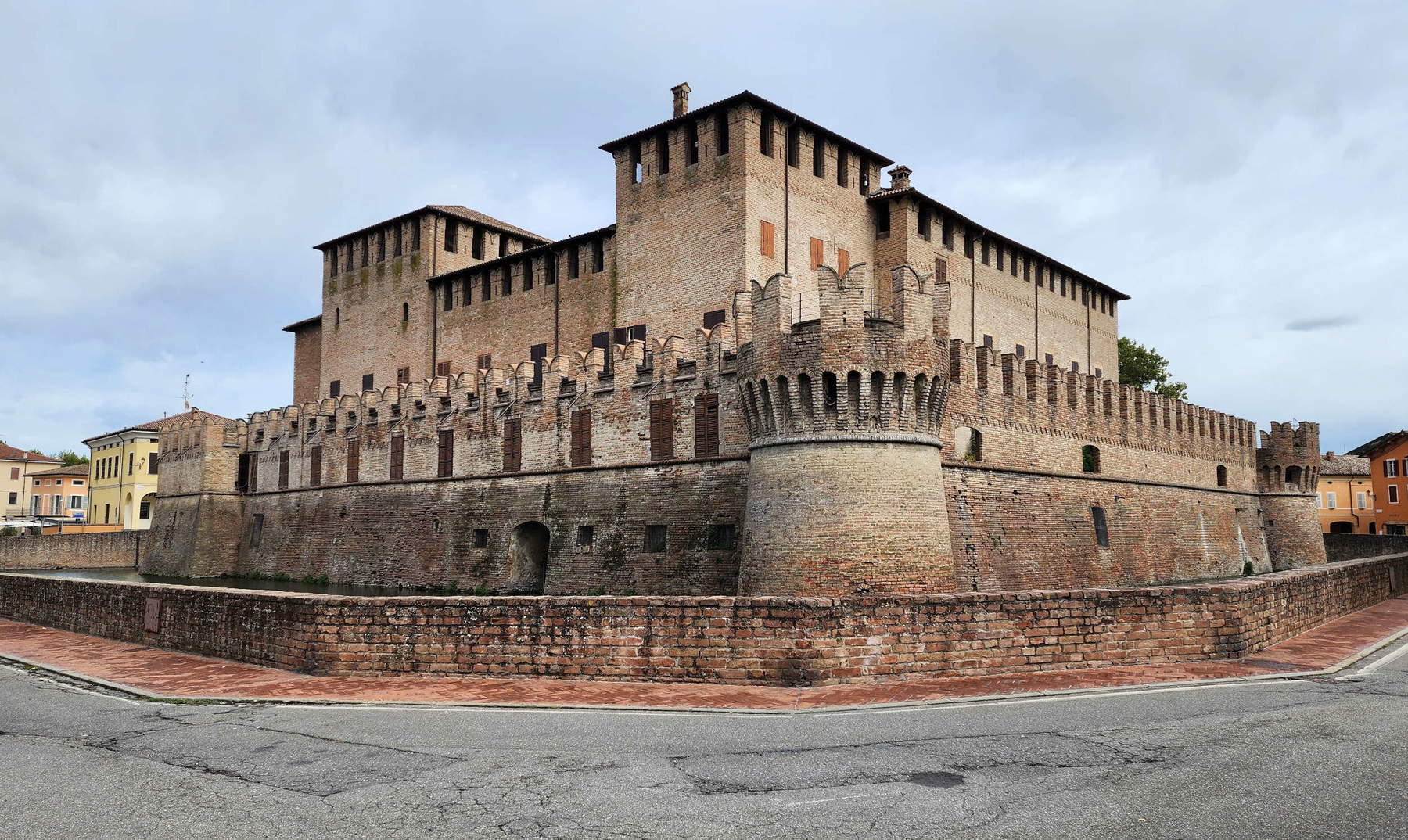
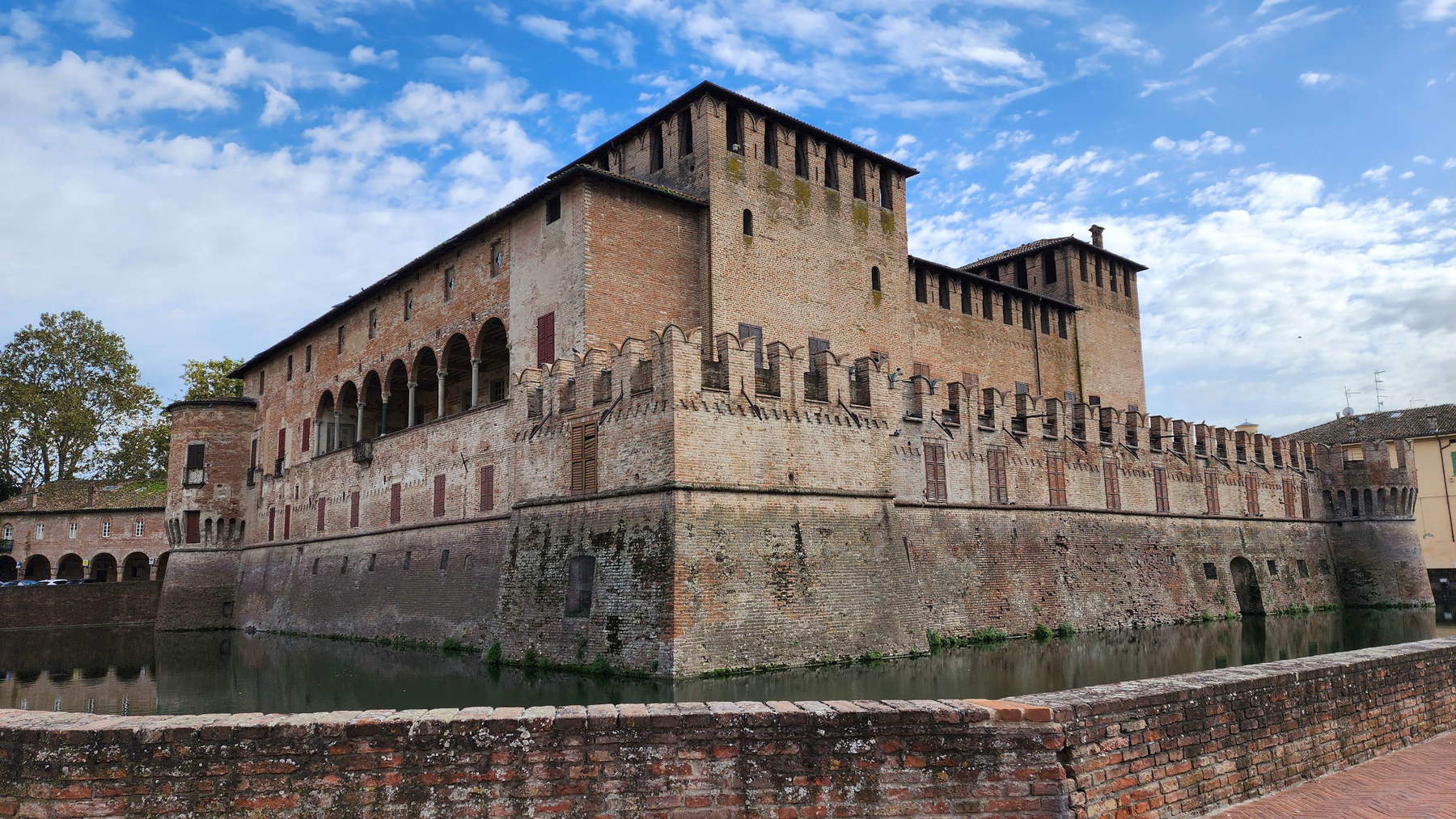

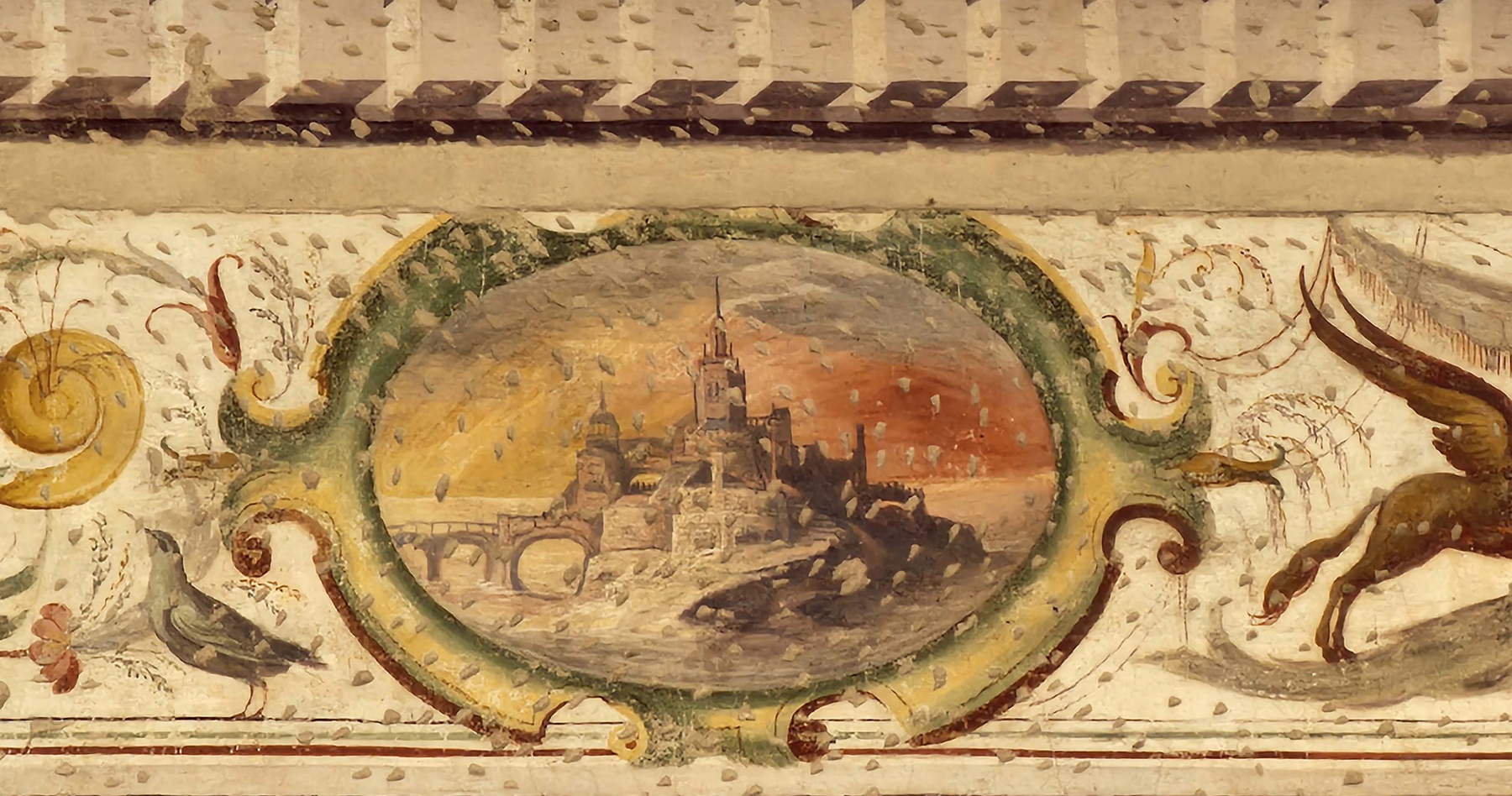
The story of the conspiracy begins not far from here, in Reggio Emilia, one late spring night in 1611. Silvia Visdomini, Alfonso’s wife, is the guest, along with her mother Ginevra and brother Ranuccio, of a family in the Reggio area, the Malaguzzi family, friends of theirs. It is a warm evening, and at dinner the windows of the Malaguzzi’s villa are left open to let in some cool air. No one suspects that the guests are being targeted: the fact is that blunderbuss shots come in through the window and hit Silvia and her mother. The count’s wife is wounded but survives; her mother-in-law dies shortly thereafter. Young Ranuccio Visdomini reports the incident to the Duke of Parma, his namesake Ranuccio Farnese, who has Alfonso arrested. It is June 10, 1611. The count will later confess to being the instigator of the attempted murder of his wife, and he may have had enough already. But things get complicated. Just five days later, by a fortuitous chance, an Umbrian bandit, a certain Onofrio Martani, servant of Gianfrancesco Sanvitale, a young marquis of Sala Baganza and cousin of Alfonso, is stopped. Martani is taken into custody following a charge of attempted bribery reported to ducal authorities by a soldier whom the man wanted to involve in certain of his robberies. A letter from Gianfrancesco is found in his possession, he lets slip a few too many half-words, is subjected to torture, and ends up confessing to the design of a conspiracy in which many of the nobles of the Parma area would be involved. Even Alfonso Sanvitale himself, who was already in prison for his own business. And then Gianfrancesco, Counts Girolamo da Correggio, Pio Torelli, Giovanni Battista Masi, Alberto di Canossa, Teodoro Scotti (the only one who died in prison as a result of torture), and even Count Orazio Simonetta, who had married the beautiful Barbara Sanseverino, to whom Torquato Tasso had dedicated a lyric in praise of her hair. She too, of course, is arrested. For all of them, the judge, the Piedmontese Filiberto Piossasco, at the end of the trial passes sentence of death. And he decrees that the bodies be quartered and hung around Parma as a warning. Ranuccio Farnese decides to spare his subjects the grisly butchery, but he does not grant any further discounts to the condemned: the only one pardoned is Girolamo da Correggio. All others end up beheaded, May 19, 1612. Legend has it that today the ghost of Barbara Sanseverino roams the Rocca di Fontanellato at night, even though the noblewoman never lived here. Suggestions given perhaps by the presence of her portrait, one of only two survivors, in the nuptial chamber of the Rocca, under the very fine wooden lacunar ceiling, in the center of which stands the coat of arms of the Sanvitale family framed with that of the Rossi di San Secondo family. It alludes to the marriage between Alessandro II Sanvitale and Margherita Rossi. Alessandro went down in history as the “repurchaser” of the Rocca di Fontanellato, as historian Guglielmo Capacchi called him.
The presence of Alfonso II among the conspirators had in fact determined the passage of the Rocca di Fontanellato, along with half of the fiefdom, to the Farnese. The remaining half would remain the property of another branch of the family, unrelated to the conspiracy, and descended by direct line from the Galeazzo portrayed by Parmigianino: it would be his nephew Alessandro, in 1635, who would buy back the half of the fief that had been confiscated by Ranuccio Farnese. The new duke, Odoardo, granted it to him as a token of recognition for his devotion to the Farnese family. The Sanvitale family thus regained possession of the fortress after a twenty-year absence, twenty years in which the manor had fallen into a state of neglect. Alexander II bought it back from the Farnese, but it would be his grandson Alexander III who would pose the problem of transforming it into a modern palace.
A character of many interests, Alexander III: he is passionate about art, mathematics, music, even mechanical engineering. And he promoted many works for the fortress: he had a chapel opened, he even had a theater built (later demolished in the 19th century: today only a few fragments of frescoes remain of the undertaking, the putti hanging on the head walls of the Gallery of the Ancestors), he filled the manor with works of art. One owes to his patronage, for example, the large still lifes by Felice Boselli hanging in the Dining Room. The public generally does not pay much attention to these small paintings hung amidst the crockery, beside the large sideboards where the house’s finest ceramics are crammed, under the vaults frescoed with the coats of arms of families related to the Sanvitale, but they are perhaps among the images that best help us understand how the counts of Fontanellato saw themselves, how they saw their lands, how they saw their lives. Felice Boselli’s still lifes are perhaps the most political works to be admired inside the Rocca di Fontanellato. There are fish everywhere: only in the market scenes depicted by the painter from Piacenza are more given to be seen. They allude to the abundance of the feudal waters. There is game, reminiscent of the many woods that dotted Fontanellato’s territory, and some of which still survive today. There are the products of the land, of course. The Sanvitale family belonged to the wealthy and pleasure-loving nobility of Emilia who loved the pleasures of the table, the land, and conviviality: it will suffice to recall that Count Luigi begins to describe the products of the territory as early as page 2 of his Memoirs around the Fortress of Fontanellato published in 1857 (“conveniences that ponno allure one to live there in trattenimenti and pleasures of hunting and fishing,” delicious and abundant wines with which the inhabitants supplied Parma itself, delicious meats, cheeses and dairy products and all the rest). A nobility that, as is obvious, loved to surround themselves with works such as Boselli’s, capable of giving clear signs of the prosperity of their lands.
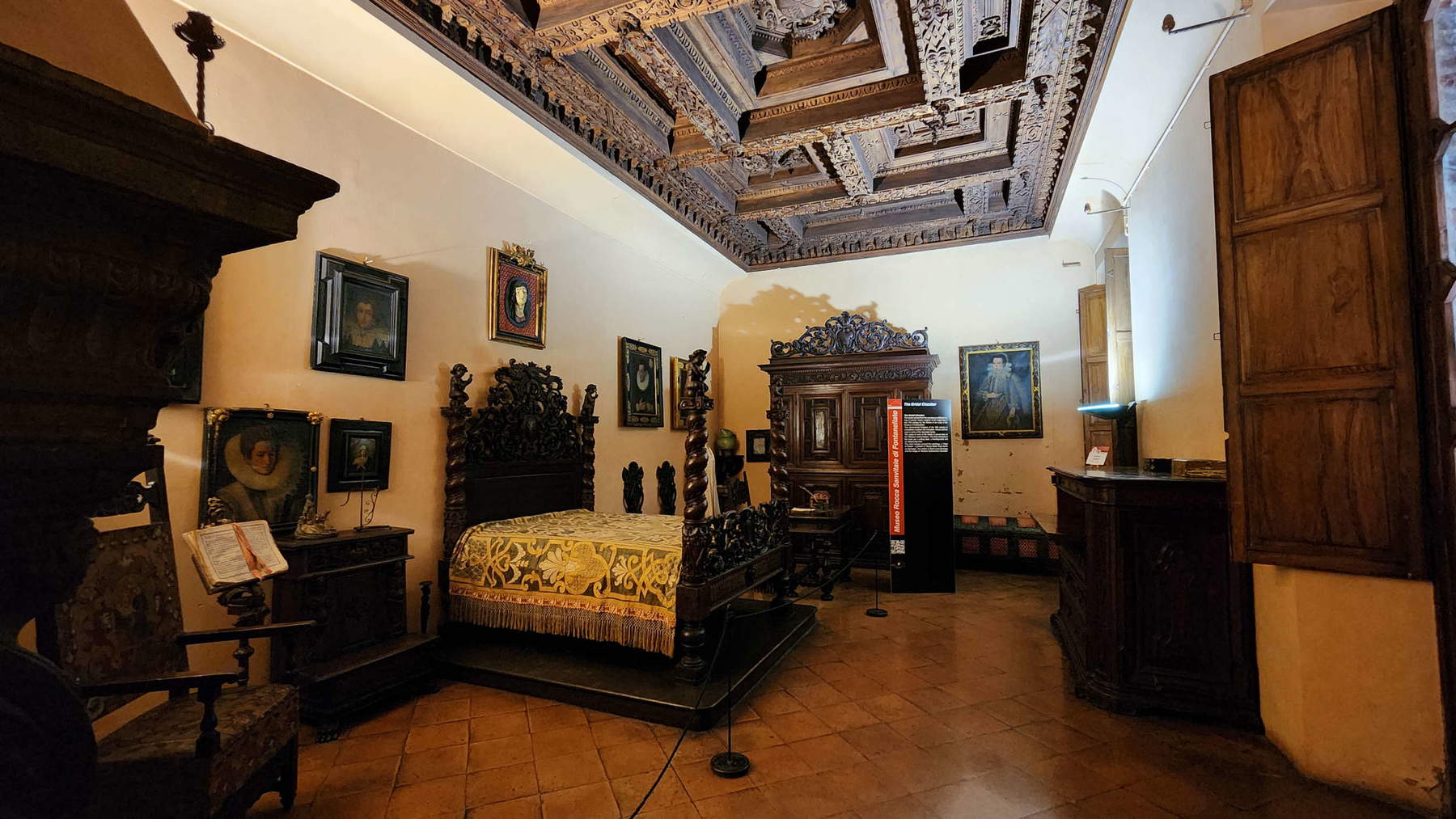


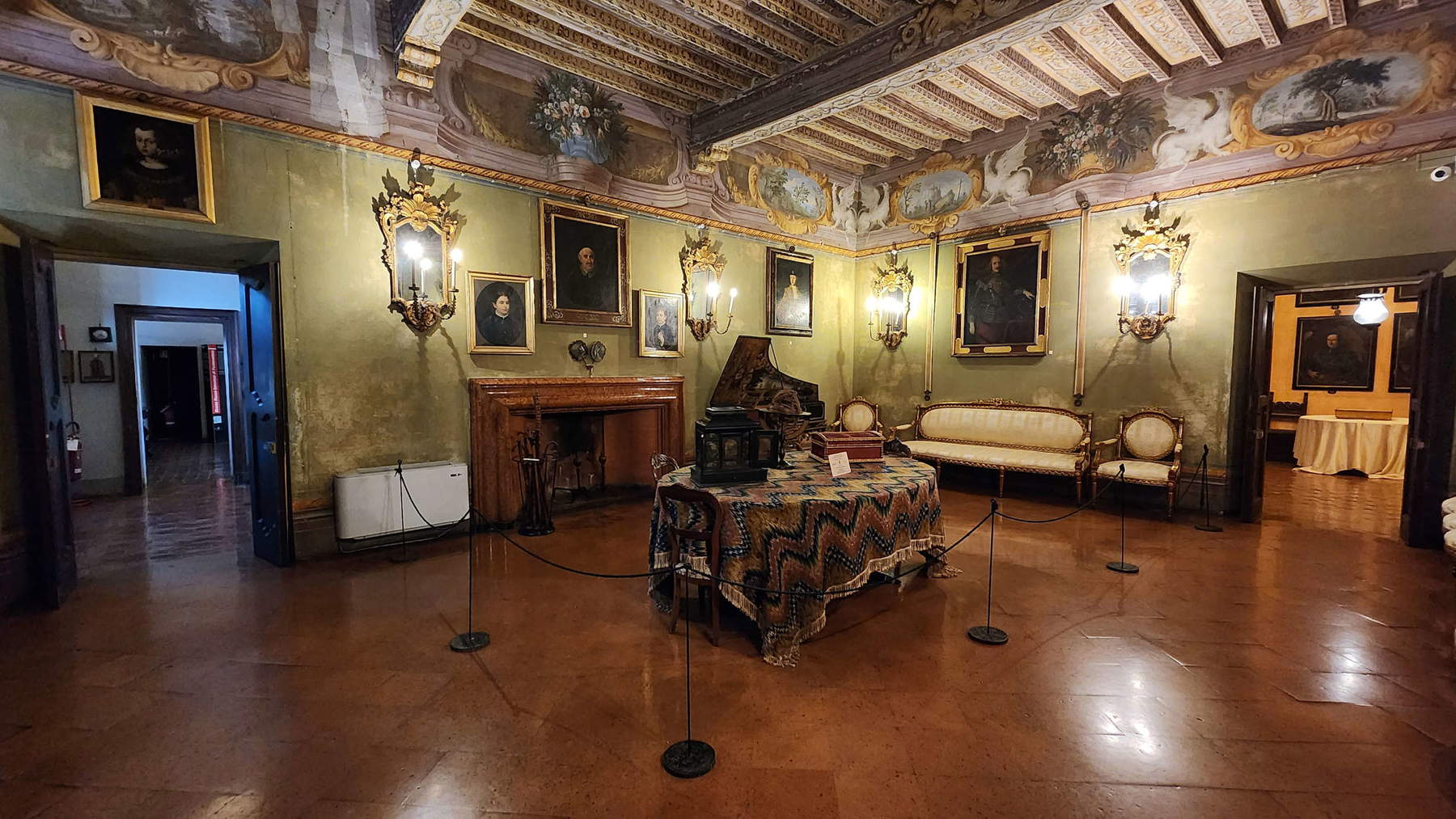
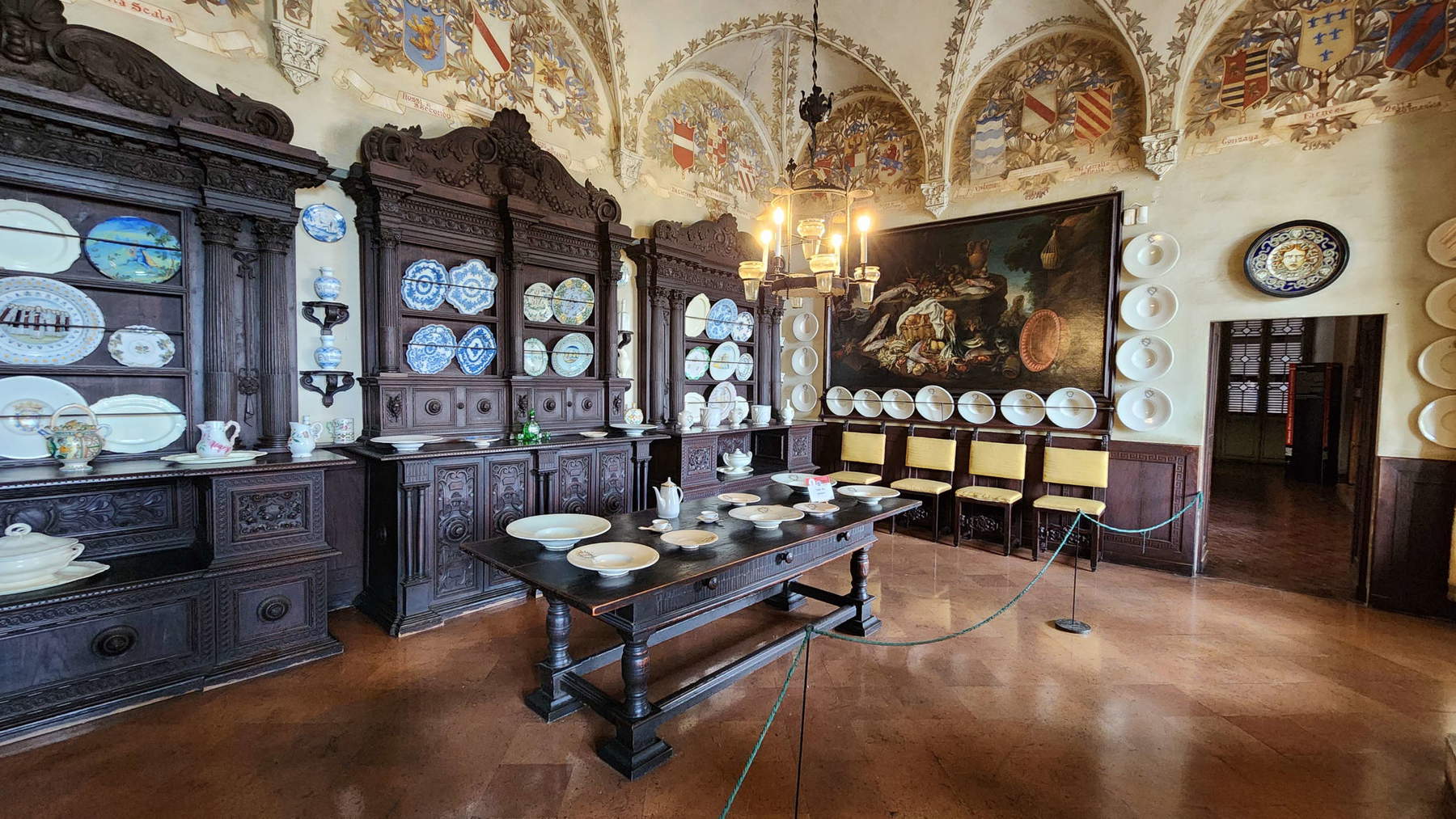
Alessandro had also hosted a Milanese scholar, Carlo Giuseppe Fontana, and had him write a Ragguaglio della Rocca di Fontanellato, published in 1696. It is here that one reads one of the earliest descriptions of the frescoes with which Parmigianino had covered Paola Gonzaga’s room: it is a small room on the first floor of the Rocca that one encounters after passing the Hall of the Equilibrist Women, wallpapered with partly surviving 16th-century grotesques of women holding themselves above curtains drawn between a series of painted Ionic columns, set to mark the space. The exact meaning of these strange naked acrobats, perhaps the work of the Milanese Cesare Cesariano, wielding bows and arrows, facing bizarre figures resembling fauns but also harpies, holding burning flashlights, eludes us. Just as the ultimate function of the room frescoed by Parmigianino still eludes.
For Augusta Ghidiglia it was perhaps the “little stove,” a sort of private bath of Paola Gonzaga, the wife of Galeazzo Sanvitale, who, observing the story of Diana, her handmaidens and the hapless hunter Actaeon, could perhaps see herself again in the image of the goddess of the hunt. For Maurizio Fagiolo dell’Arco the room could have been a balneum nuptiale, the place of the coniunctio between the feminine principle (the sponsa, Paola Gonzaga) and the masculine principle (the sponsus, Galeazzo Sanvitale), but although alchemical doctrines were fashionable at the time, we have no evidence that the count delighted in such amusements. Gianni Guadalupi and Franco Maria Ricci noted that the deer-turned Actaeon has unmistakably female features. He is modeled on the figure of a nymph, and this could be no accident or mistake. Perhaps then Actaeon is none other than Paola Gonzaga herself: an innocent struck down by Diana. Exactly like the countess, who had lost a child, perhaps the child depicted by Parmigianino on the vault of the room, with a coral necklace around his neck according to the custom of the time: Diana was a goddess linked to childbirth and motherhood, and perhaps she was held responsible for that painful loss. So, the setting was perhaps meant to be a small cenotaph. Massimo Mussini has criticized this idea, however, on the grounds that such a use is not otherwise ascertained at those chronological heights: more likely, then, that it was a studiolo.
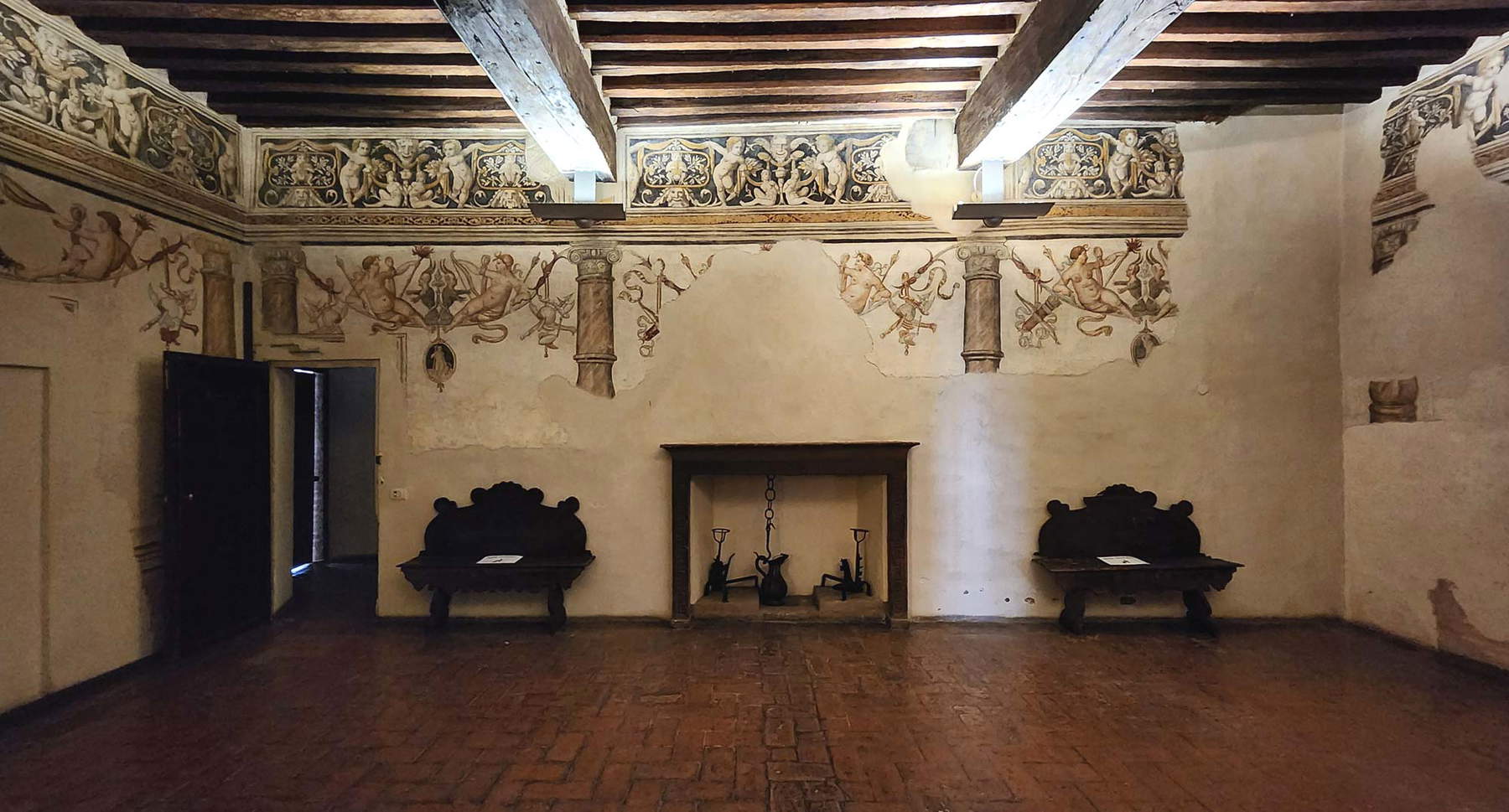
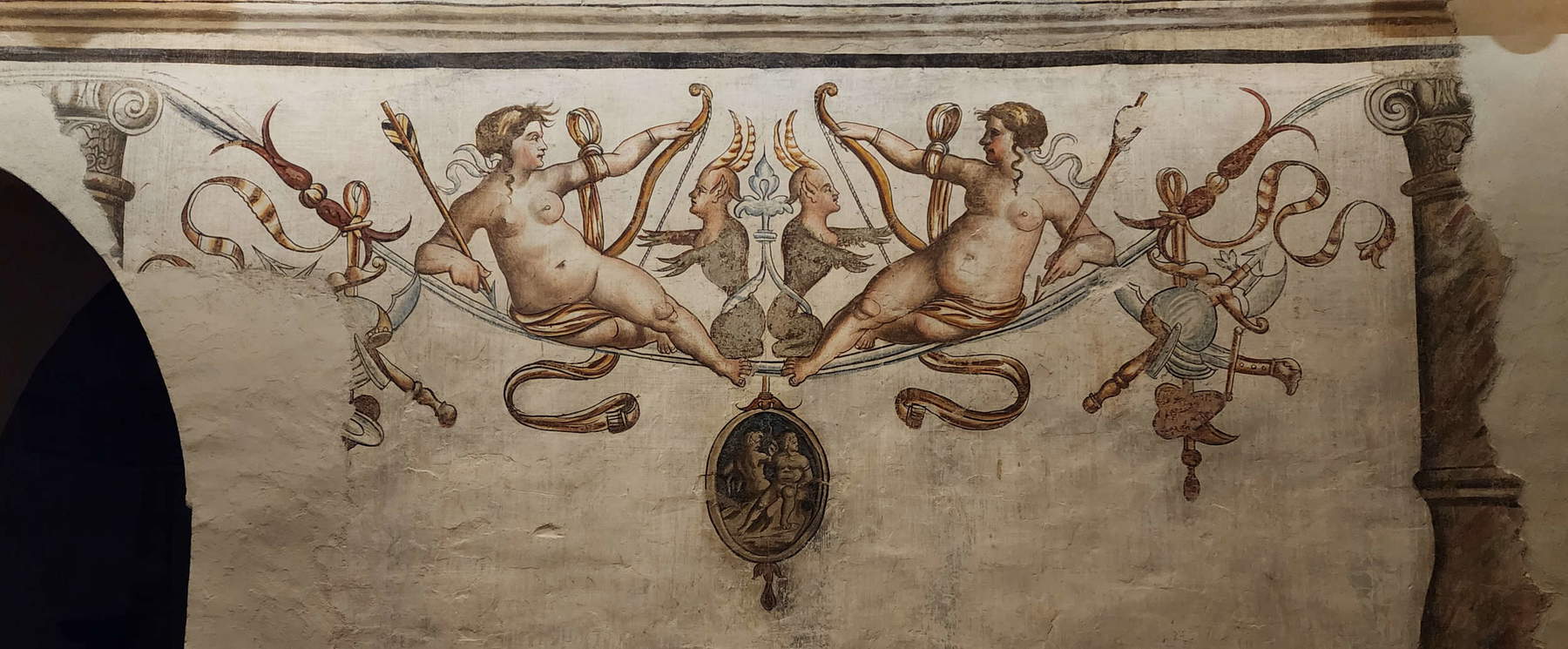
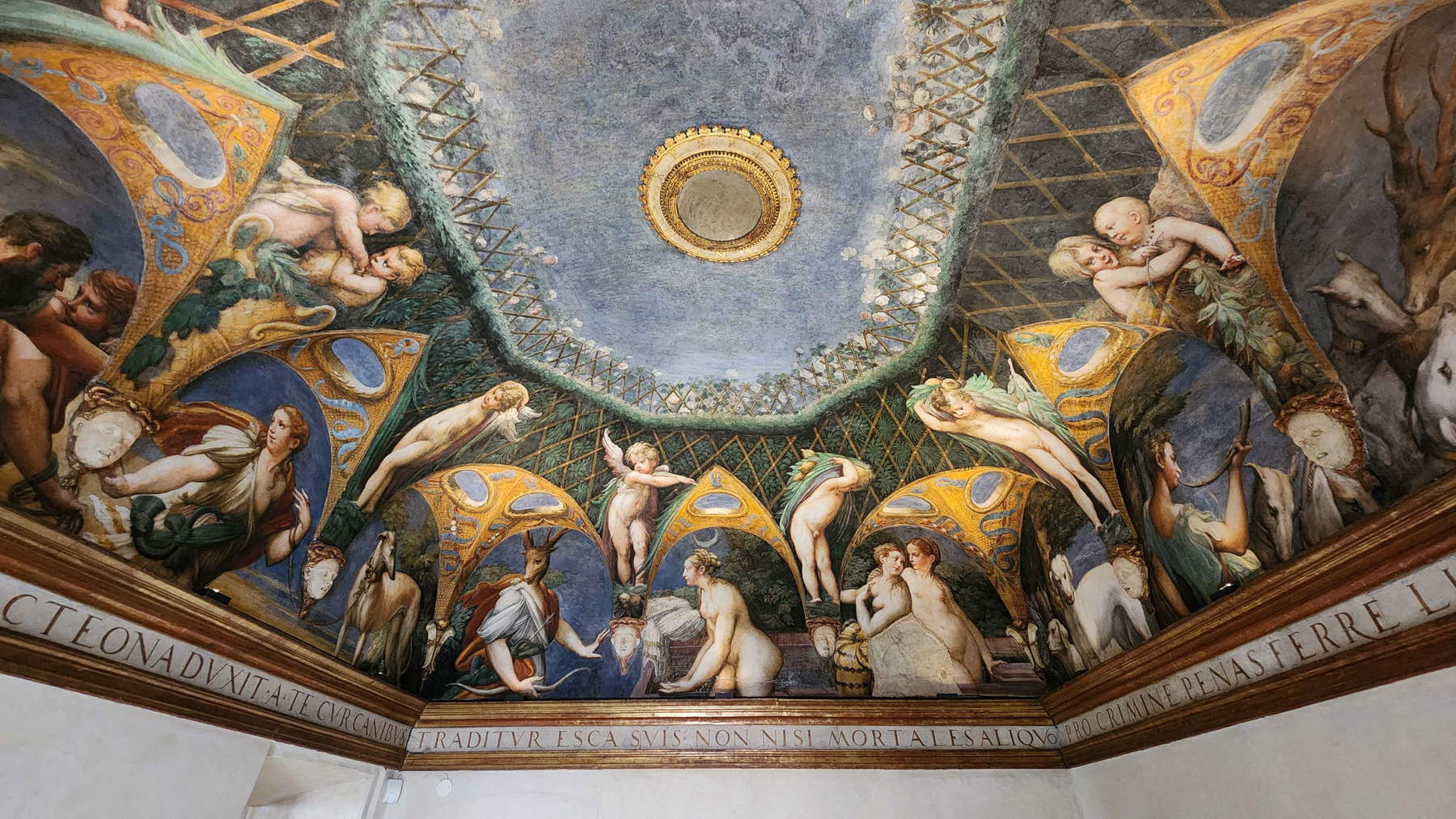




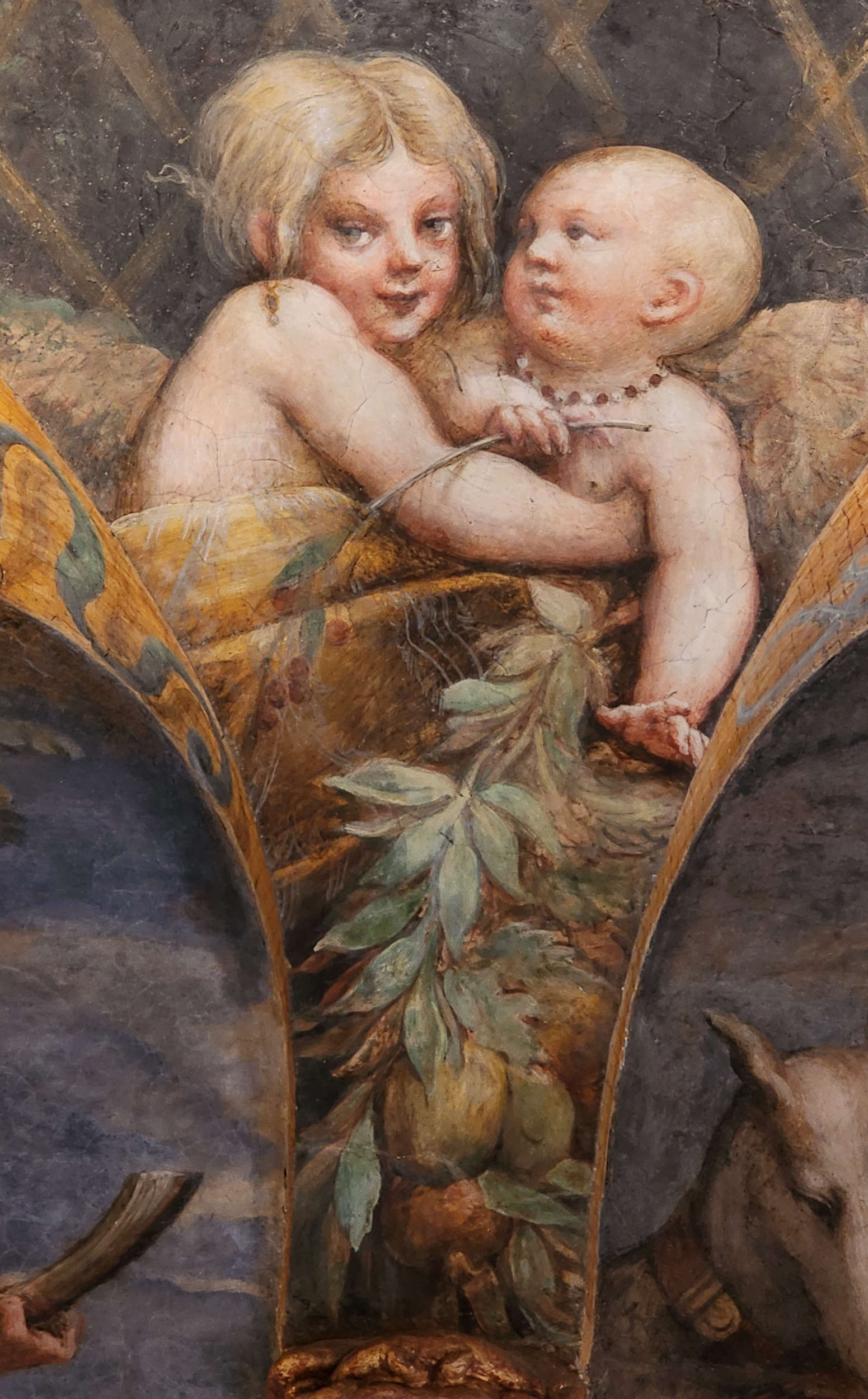
Count Luigi, in his Memoirs, suggested between the lines that Parmigianino had engaged in a kind of competition with Correggio, his illustrious fellow citizen. If, however, Correggio, echoing an idea of Argan, is the painter of naturalness, then Parmigianino is the painter of artificiality. And it is perhaps in Fontanellato, more than elsewhere, that Francesco Mazzola “challenged,” Argan would have said, the ideas of Antonio Allegri. With a painting that is intellectual, difficult, at times even disturbing, a painting that transforms the composed, classical arbor of the Correggesque Camera di San Paolo into the frenetic setting of a fierce fairy tale: no longer the balanced, closed pavilion of Correggio, but an open vault over a blue sky whose illusionism is, however, ultimately artificially negated by the presence of the mirror, a real mirror, around which runs the motto “Respice finem,” an invitation to observe the end of Actaeon’s story.
It is hard to imagine that Parmigianino had in mind the Latin phrase from the Gesta Romanorum (“Quidquid agas, prudenter agas, et respice finem”: Whatever you do, do it prudently, and watch the end): one cannot blame Actaeon for not being prudent. He had just been unlucky. Simpler, and more fitting, to imagine a similar biblical reference, the book of Sirach, recalled by David Ekserdjian as a possible source of inspiration: “In omnibus operibus tuis memorare novissima tua, et in aeternum non peccabis” (“In all your works remember your end, and you shall never fall into sin”). A bleak memento mori, one would think. Except that the room is manned by the tawny, luminous figure of Demeter, whom we observe immediately after the final episode. The scene is moving: the dogs pounce on Actaeon transformed into a stag, but their eyes seem almost filled with pity, seeming almost to warn that this is no ordinary deer. Parmigianino then spares us the animal’s torment, he only lets us imagine it. And then, here in a niche bathed in golden light is the goddess of crops, of harvests, of nature’s most precious fruits. Goddess of life who is not afraid of Diana’s weapons. It is as if Galeazzo Sanvitale wanted to tell his wife that death is a passage, that other gems will be born, that new life will erase the past. And that the cycle will repeat itself endlessly. The meaning of the mystery rites that were celebrated at Eleusis in honor of Demeter: to watch the end, knowing that then, at the height of dismay, Plutarch would have said, “a marvelous light presents itself before one’s eyes and one crosses pure places and grasslands echoing with voices and dances.” Rebirth after death. What also happened at the Fortress of Fontanellato. Its overt secret that resonates within these walls.
Warning: the translation into English of the original Italian article was created using automatic tools. We undertake to review all articles, but we do not guarantee the total absence of inaccuracies in the translation due to the program. You can find the original by clicking on the ITA button. If you find any mistake,please contact us.




























